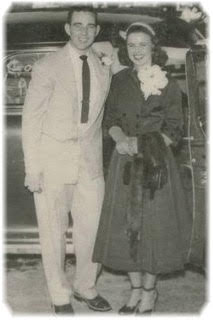Suitcoats and Stenography—College Life in the 1940’s

Provided by Ianna Hondros-McCarthy
Ianna’s Grandparents
February 8, 2016
“Getting assignments done in a timely manner was probably my biggest concern in college,” said George McCarthy, now in his 90th year, sitting with his wife, Virginia, trying to figure out how to find the channel on TV showing a football game being played by his alma mater, Boston College. “I never did my work on time,” he said.
“I was actually quite organized,” Virginia said, to the contrary.
Maybe not much has changed since then: opposites still attract and procrastinating is still in vogue.
Virginia’s favorite class had been Stenography—a class definitely no longer in UNE’s course catalogue, and furthermore, not in my vocabulary, for sure. “It was shorthand,” Virginia told me, and her light blue eyes became even lighter to remember it. “I loved doing figures of lines and circles that were shortcuts to words,” she said, smiling and making shapes with her hands in the air. It’s always a little jarring to see someone excited over something you’ve never heard of, but maybe shorthand is akin to made-up languages in notes from middle school, or doodling. Or maybe it’s like the fun of speaking in abrevs.
When I asked them about their social lives, it took them a minute to recall. Unlike these days, college wasn’t about being social for them. “You just didn’t go out after class. Everyone had to go to work in the morning,” Virginia said, who had been working at Remington Guns in 1942, a company that manufactured ammo for the WWII. College for her was night classes at Bradshaw Business School, where she was in classes with 6-10 other people, learning how to use the machines her company used, like electric typewriters, mimeograph machines (copiers), adding machines (now condensed into calculators), etc. The sole reason to go to college, in both her and George’s minds, was to learn things that would help them get better jobs. And the classes were less than $100 each!
When asked about what social life they did have, again, there were a bit of crickets before either of them responded. “An average Friday night was doing homework. On Saturdays we usually went to the Commodore Ballroom.”
The men wore suit coats, and the women wore skirts and nice blouses. If there was any smell of liquor on your breath, the doorman turned you away. Soda was everyone’s drink of choice inside, and the doors closed at 11pm. “We had to get the last bus home, and that was at 11:30pm,” Virginia said. “Yes, you had to get the girls home by a certain hour,” George corroborated.
“But you did drink, right?” I asked. “Well, yes, a little. But you have to remember, I had to drive, so couldn’t drink too much. Maybe just a couple beers—never too much.” George’s face was serious—a man who clearly took responsibility seriously.
“What were your favorite drinks back then?”
“Probably a Lime Rickey,” Virginia said thoughtfully, “made with rum and lime soda.” She never drank beer, and her drink of choice now is a white zin spritzer.
“I used to drink Harvard’s lager beer,” George added.
I asked them if they ever noticed any sexual misconduct or rape at those dances, as they seemed like the closest thing to our “college parties,” where that’s unfortunately become a common occurrence. I was answered with blanched, confused looks and a resounding, “no.”
Well, at least procrastination hasn’t changed in the past 75 years.


